|
| |
There is a fine line between
bombers (here) and fighters, in that attack aircraft
could reasonably be categorised as either (or as a separate category on their
own). I have included attack aircraft with fighters, on the somewhat arbitrary
grounds that more of them are multi-role aircraft. Inclusion here of types like
the Buccaneer and Swordfish is arguable .... but anyway, here they are.
| AMERICA |
 |
|
It is astounding to think that the prototype
of the greatest American wartime bomber flew in July 1935, a full
six years before America's entry into the war. The Boeing B-17
Flying Fortress was a
hugely capable aircraft, able to take up to 17,600lb of bombs over
short ranges and smaller loads for up to 1,850 miles. Its other
armament was fearsome: thirteen 0.5 inch machine guns. All told,
12,700 were produced.
Several are still airworthy including this
one, photographed at Duxford on a scorching hot day in September
2004. |
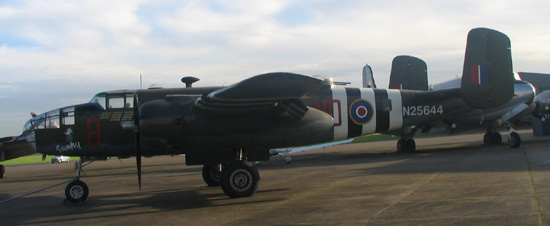 |
The North American B-25 Mitchell medium
bomber was used in a wide variety of bombing and attack roles in the
second world war. It could carry up to 4,000lb of bombs. Its two
1,850hp Wright Cyclone engines gave it a top speed of 275mph. Its
range was 1,275 miles. Over 11,000 were built.
This one is maintained in airworthy condition at
North Weald, where it was pictured in December 2005. |
|
|
The Boeing B-52 Stratofortress is an extraordinary success
story. It was designed as a jet replacement for the giant ten engined Convair B-36, which had itself replaced the wartime Boeing
Superfortress. With eight jet engines in four pairs under the huge
swept wings, the B-52 is a very powerful aircraft. An odd feature is
the undercarriage, in two pairs under the fuselage, with stabilising
outriggers on the wings.
It first flew in April 1952 and is still in
service in 2005, 53 years later.
These two B-52Hs were at air displays at
Fairford in the UK, the top one in the 1980s and the lower one in
2005. |

 |
The Rockwell B-1 Lancer is the most
successful supersonic bomber the USA has produced. (actually the
competition - the B-58 Hustler and the cancelled B-70 Valkyrie are
the only others - is limited!). It is an extremely capable aircraft,
and has succeeded the B-52 in most of its deep strike missions.
The top picture shows a B-1A at Farnborough in September 1982.
The lower picture is of a B-1B at Fairford in July 2005. |
| BRITAIN |
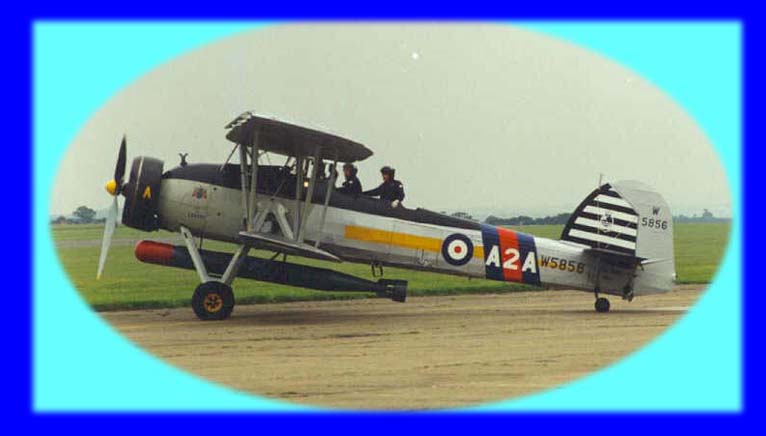 |
|
The Fairey Swordfish is an odd aircraft to
include as a bomber, but its record belies its benign appearance. It
was the Royal Navy's first proper carrier-borne torpedo bomber.
Despite first flying in April 1934, it continued in service
throughout the second world war. Its most famous achievement was to
cripple the ultra-modern battleship `Bismarck' in 1941, leaving it a
sitting target for the Navy to finish off. Aside from its capability
as a stable and accurate torpedo launcher, it was incredibly robust:
they frequently arrived back full of large holes, but still happily
flying. 2,400 were made. The navy keeps
two, including this one, in its historic flight: it is seen here at
Duxford in 1998. |
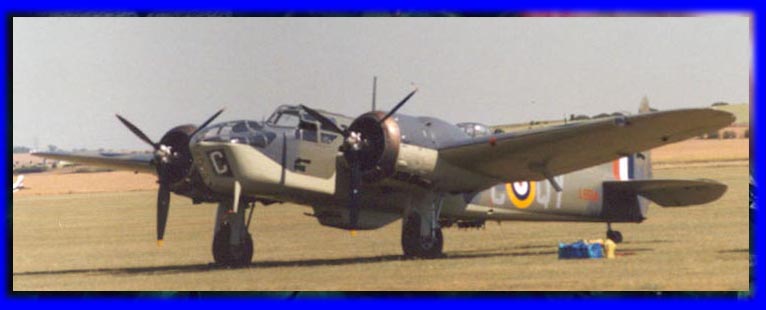 |
When the Bristol Blenheim first flew in June
1936, it was the fastest of its class in the world. It could deliver
1,000 lb of bombs at 265mph pver 1,460 miles. Over 3,000 were built,
and saw service in every theatre of the second world war.
This one was restored to flying condition and
took part in the air display at Duxford in 1996. |
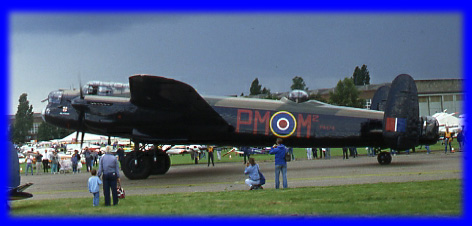 |
The Avro Lancaster was Britain's best and
most versatile bomber of the second world war. It first flew in
January 1941. It was unusual for a bomber in being powered by
Rolls-Royce Merlin engines, until then always thought of as a
fighter engine. This gave it a top speed of 290mph, a range of 1,660
miles and a bomb load of up to 14,000lb, although some special
mission aircraft were able to lift the 22,000lb Grand Slam bomb.
Modified Lancasters carried the famous `bouncing bomb' which
destroyed the dams which supplied water to the German Ruhr industry.
7,374 Lancasters were built including this, the
last flying example, seen at Cranfield in July 1988. |
 |
The Avro Lincoln was a beefed-up successor to
the Lancaster. Because it first flew in June 1944, close to the end
of the war, only 500 were made. Payload was increased to a massive
38,000lb. This Lincoln was pictured at
the Argentine Air Force museum in Buenos Aires in 1999. |
 |
The De Havilland DH98 Mosquito was designed to be
the smallest aircraft which would fit around two Merlin engines.
Taking much learning from the DH88 Comet racer, it was built for
speed: it could manage 408mph, astounding for a bomber of the
period. It first flew in November 1940. Through economy of weight
(it was built largely of wood), it could lift 4,000 lb of bombs. It
was adapted for many roles including reconnaisance and night
fighting. This, the last airworthy
example, was seen at Mildenhall in June 1984. |
|
|
The English Electric Canberra first flew in
May 1949, making it one of the world's first jet bombers. It was
designed by W.E. Petter at the English Electric factory in Preston,
Lancashire. Range is up to 3,800 miles with a cruising speed of 580
mph and a bomb load of 8,000 lb. It is powered by two Rolls-Royce
Avon turbojets. It was built in numerous versions.
It served in the Royal Air Force for over 50 years, as well as many
overseas customers. Altogether 982 were built in Britain, and 403
under license in America by Martin as B-57s. Pictured
(top) is a
modified B(I)8, operated by the Aircraft & Armament Experimental
Establishment and seen at Greenham Common in June 1981. (Below) a
Canberra PR9 photographic reconnaisance version, still in service
and seen at Fairford in July 2005. (Below that) a Canberra B2
landing at Marham in July 1976. (Bottom) a Canberra T17 at
Finningley in 1976. |

 |
The Handley Page Victor was one of three
aircraft ordered by the RAF to carry its nuclear deterrent during
the cold war, and known as `V bombers'. An elegant design with a crescent wing (to keep a
constant critical Mach number at high speed flight), the Victor
first flew in December 1952. It had a typical bomb load of 35,000lb,
top speed of Mach 0.95 and range of 6,000 miles.
After a long career in the bomber role, many were converted to
in-flight refuelling tankers. It was powered by four Armstrong
Whitworth Sapphire turbojets. Only 60 were built, all serving with
the Royal Air Force. The top
one was seen at Greenham Common in July 1983. The lower picture was
at Finningley in 1976. They continued in RAF
service well into the 1990s. |
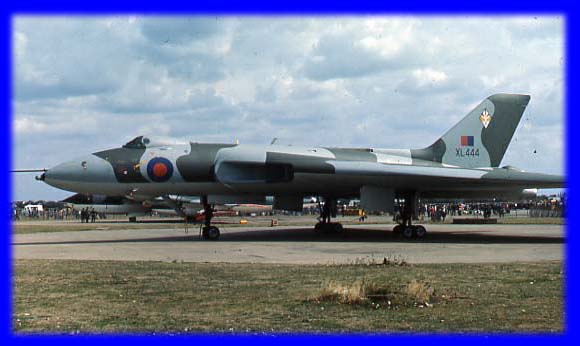
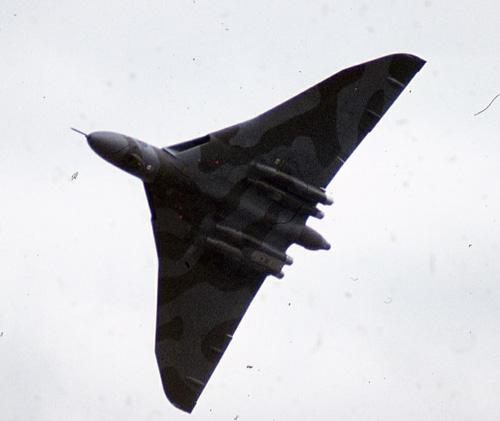 |
The Avro Vulcan is Ivy's favourite aircraft!
It was the third, and technically the best, of the V bombers. At the
time, there was great scepticism over whether a delta wing was a
feasible platform for a very large aircraft. The Vulcan proved that
it is. It was known as the `Aluminum Overcast' by the Americans,
partly because the wing was so vast that it covered a huge area of
sky, and partly because they couldn't spell Aluminium. Vulcans
consistently won the international `Giant Voice' bombing
competitions in Nevada against some of the best competition in the
world. They were incredibly powerful - and incredibly noisy! 136
were built, all for the RAF. They could carry 21 thousand pound
bombs, or the huge Blue Steel air to surface missile. Maximum speed
was 625mph and range was 3,000 miles.
Amazingly for this huge aircraft, Avro's test pilot, Roly Falk
actually rolled one of the early production aircraft during a
display at Farnborough! The Avro engineers were very anxious, and
inspected the aircraft afterwards for signs of damage: there was
none, and the aircraft flew happily for many year with the RAF.
The one in the top picture, belonging to 617 squadron (of Dambusters fame - note the bursting dam badge on the tail), was at
Finningley in 1976. The lower picture is a Vulcan B2 flying at Hurn
in August 1984, showing the vast area of the delta wing. |
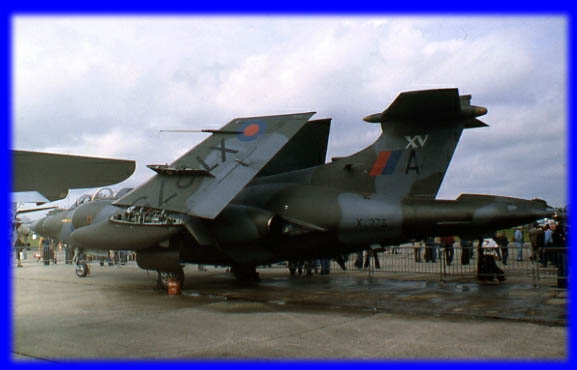
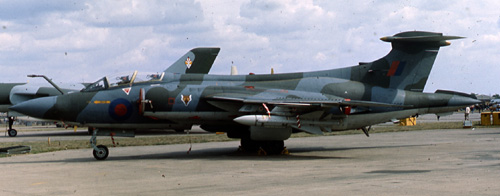 |
The Blackburn Buccaneer is one of David's
five favourite aircraft! It was designed as a Naval strike attack
aircraft, hence the folding wings to make room on aircraft carrier
decks. Most manufacturers thought the specification was impossible,
but by innovative design Blackburn managed to meet it. It had a
rotating bomb bay, to keep the airflow unobstructed with the bomb
bay open. The wings were made of a solid lump of aluminium, milled
to shape and with systems then installed. Air was bled from the
engine's compressor and blown through slots in the wing to increase
boundary layer control and thus improve handling at slow speed. The
bulge behind the engine was partly for `area rule' (to reduce
transonic drag) and partly to house the fuel tanks. The large
airbrakes at the back were a Blackburn innovation, later used on
other types including the BAe 146 airliner.
Top: Buccaneer from 15 Squadron based at Laarbruch
in Germany at Greenham Common in June 1979. Bottom: Buccaneer
at Finningley in September 1976. |
| GERMANY |
|
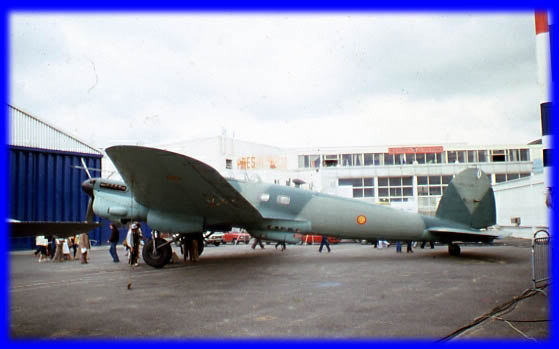 |
|
|
The Heinkel He111 was one of the bombers used
by the Luftwaffe to bomb Britain in the second world war. Always
intended as a bomber, it had first flown as an airliner to
circumvent the restrictions on German armaments after the first
world war. Its handling characteristics were good, and it had a
number of interestign features including a lovely emergency device
for lowering the undercarriage in the event of a hydraulic failure:
a large cable cutter! Bomb load was small compared to the B-17 or
the Lancaster, being only 5,500lb.
Many, including this one seen at Le Bourget in
June 1981, were used by the Spanish air force until well after the
end of the war, and actually powered by Rolls-Royce Merlin engines
in place of the original Junkers Jumo. |





|